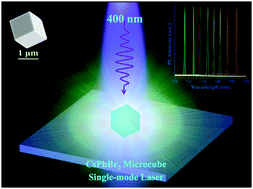Single-mode lasing and 3D confinement from perovskite micro-cubic cavity†
Abstract
Obtaining single-mode lasing with excellent stability and beam quality is highly desirable but still challenging. Although microplatelet optical cavities attract great attention because of their important lasing characteristics of directionality and high-power output light, they suffer from weak light confinement, which restricts applications of a single-mode laser. Herein, we increased the vertical thickness of the microplatelet cavity appropriately to achieve 3D light confinement in a CsPbBr3 micro-cubic cavity, from which single-mode lasing with an extreme narrow linewidth of 0.064 nm (Q ∼ 8500) was successfully achieved at room temperature. Besides, the microcavity we prepared exhibits superb capability for the output of continuous stable single-mode lasing. Different growth stages of cavities were found and a related growth mechanism was analyzed, indicating that the micro-cubic cavities evolved from nanospheres. Moreover, interesting multi-mode lasing spectra with higher-order transvers modes were observed in larger micro-cubic cavities. All these results suggest that 3D CsPbBr3 micro-cubic cavities, which provide improved photo-physical properties, are important for fundamental studies and future applications in photonic devices.



 Please wait while we load your content...
Please wait while we load your content...